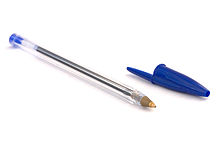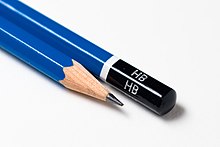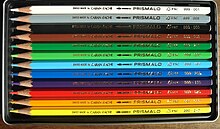1.point
The main modern types of pens can be categorized by the kind of writing tip or point on the pen:
- A ballpoint pen dispenses ink by rolling a small hard sphere, usually 0.5–1.2 mm and made of brass, steel or tungsten carbide.[3] The ink dries almost immediately on contact with paper. The ballpoint pen is usually reliable and comes in both inexpensive and expensive types. It has replaced the fountain pen as the most common tool for everyday writing.
- A rollerball pen dispenses a water-based liquid or gel ink through a ball tip similar to that of a ballpoint pen. The less-viscous ink is more easily absorbed by paper than oil-based ink, and the pen moves more easily across a writing surface. The rollerball pen was initially designed to combine the convenience of a ballpoint pen with the smooth "wet ink" effect of a fountain pen. Gel inks are available in a range of colors, including metallic paint colors, glitter effects, neon, blurred effects, saturated colors, pastel tones, vibrantshades, shady colors, invisible ink, see-through effect, shiny colors, and glow-in-the-dark effects.
- A fountain pen uses water-based liquid ink delivered through a nib. The ink flows from a reservoir through a "feed" to the nib, then through the nib, due to capillary action and gravity. The nib has no moving parts and delivers ink through a thin slit to the writing surface. A fountain pen reservoir can be refillable or disposable, this disposable type being an ink cartridge. A pen with a refillable reservoir may have a mechanism, such as a piston, to draw ink from a bottle through the nib, or it may require refilling with an eyedropper. Refill reservoirs, also known as cartridge converters, are available for some pens which use disposable cartridges.
- A marker, or felt-tip pen, has a porous tip of fibrous material. The smallest, finest-tipped markers are used for writing on paper. Medium-tip markers are often used by children for coloring and drawing. Larger markers are used for writing on other surfaces such as corrugated boxes, whiteboards and for chalkboards, often called "liquid chalk" or "chalkboard markers." Markers with wide tips and bright but transparent ink, called highlighters, are used to mark existing text. Markers designed for children or for temporary writing (as with a whiteboard or overhead projector) typically use non-permanent inks. Large markers used to label shipping cases or other packages are usually permanent markers.
2. point
Pencil
From Wikipedia, the free encyclopedia
This article is about the writing implement. For other uses, see Pencil (disambiguation).
A pencil is a writing implement or art medium constructed of a narrow, solid pigment core inside a protective casing which prevents the core from being broken or leaving marks on the user’s hand during use.
Pencils create marks by physical abrasion, leaving behind a trail of solid core material that adheres to a sheet of paper or other surface. They are distinct from pens, which instead disperse a trail of liquid or gel ink that stains the light colour of the paper.
Most pencil cores are made of graphite mixed with a clay binder which leaves grey or black marks that can be easily erased. Graphite pencils are used for both writing and drawing and result in durable markings: though writing is easily removable with an eraser, it is otherwise resistant to moisture, most chemicals, ultraviolet radiation, and natural aging. Other types of pencil core are less widely used, such as charcoal pencils, which are mainly used by artists for drawing and sketching. Coloured pencils are sometimes used by teachers or editors to correct submitted texts, but are typically regarded as art supplies, especially those with waxy core binders that tend to smear on paper instead of erasing. Grease pencils have a softer, crayon-like waxy core that can leave marks on smooth surfaces such as glass or porcelain.
The most common type of pencil casing is of thin wood, usually hexagonal in section but sometimes cylindrical, permanently bonded to the core. Similar permanent casings may be constructed of other materials such as plastic or paper. To use the pencil, the casing must be carved or peeled off to expose the working end of the core as a sharp point. Mechanical pencils have more elaborate casings which support mobile pieces of pigment core that can be extended or retracted through the casing tip as needed.



